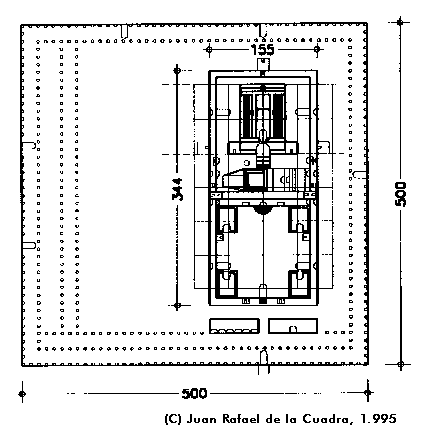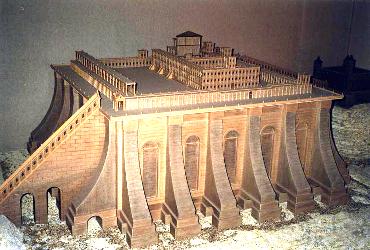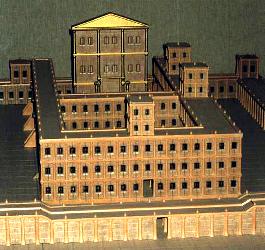
Thirsty of knowing that God knows
Judá León was given to permutations
of letters and complex variations
and finally it pronounced the Name that is the KeyJorge Luis Borges: "The Golem", in The other one, the same one (1964)
The influence of the beautiful engravings of Villalpando and of the solomonism like ideal of perfection will be a constant starting from the XVII century, and it will even be materialized in real constructions as the Portuguese synagogue of Amsterdam (1671-75), the baldachin of San Pedro of Bernini, San Carlo's inscriptions the Corso in Rome and other constructions of the Italian southern Baroque. Similar influences have also been pointed out in the church of San Luis from Seville (1699-1731) of Leonardo Figueroa. They should also stand out other iconographic sources, like the engravings. Among the hebrew talmuds, it had special influence the Amsterdam Haggadah of 1695 by Abraham ben Jacob.



On the plant of L'Empéreur, he adds a perspective of the group that will be the base of future images, as that of Caramuel. The columns that represent the piazzas of the enclosure are a poor imitation of the architecture of Villalpando, imitation that will have their maximum expression in the buttresses of the mount and in the ornaments and sacred furniture. The back part of the Portuguese Synagogue of Amsterdam was based partially on its reconstruction.

|
Jacob Jehuda Leon father, their grandfather and their great-grandfather lived in Portugal, possession of the Spanish Crown since 1584. Their father, Simão of Leão, well-known in Amsterdam like Abraham of León, was born toward 1583 and it was to merchant in Tavarede and Buarcos (to the This of Coimbra). Their mother called herself Felipa of Fonseca. Simão, with its wife, its children and its mother-in-law, escaped from Portugal in 1605, going by Seville and France, and hugged the Jewish religion after settling down in Amsterdam. There, Jacob studied under it guides her of Isaac Uziel, happening to the rabbi Isaac Athias in the synagogue of Cardozo, Hamburgo, toward 1628. In 1635 it returned to Amsterdam like hakham of one of the three Portuguese Jewish communities, of where he went to Middelburg after 1639. There the Misnah studied next to the Christian student Abraham Boreel. During this period, it built the scale model of the Tempers, writing in 1642 to small guide in Spanish. That same year he carried out to version in Dutch, to which they followed the other versions.
(By Ph. Dr. Adri K. Offenberg, from Universiteitsbibliotheek de Amsterdam, upon a comunication from Ph. Dr. Edgar Samuel, of London, that picked up the information personally of the files of the Inquisition of Torro do Tombo in Lisbon. «Jacob Jehudah Leon en zijn tempelmodel: een joods-crhistelijk project», en De Zeventiende Eeuw, p. 38, jaargang 9-1, Verloren, 1993.) |
- A.K. Offenberg, «Jacob Jehuda Leon (1602-1675) and his Model of the Temple», in Jewish-Christian relations in the Seventh Century. Studies and Documents, pp. 95-115, ed. J. Van den Berg y Ernestine G.E. Van der Wall, Kluwer Academic Publishers, Dordrecht-Boston-Londres, 1988.
- Juan Antonio Ramírez, «Jacob Juda León y el modelo tridimensional del Templo», en Dios arquitecto, pp. 100-103, Siruela, Madrid, 1992.